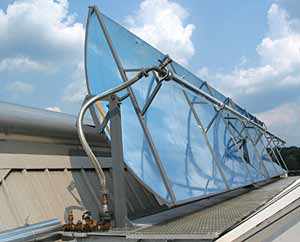An Evolving Edifice That Will Improve With Time
Many clients, one project
The center is the first project that Busby Perkins+Will is designing with a three-dimensional, parametric building information model. The model's interference-checking capabilities have been particularly useful for coordinating among the architectural design team and the various consultants, says Nielsen. And the 3D visualization tools have helped explain the building to its many constituents. "With four client institutions, each with its own research clusters, at times there are 30 people at the table during planning meetings," he says.
The center's designers say that the 3D model will also help the industry close the gap between predicted and actual performance. For the life of the building, CIRS's various systems and components will be "super-monitored," says Stantec's McCarry. Information regarding such factors as energy and water use, indoor air quality, and temperature will be continuously and systematically gathered from nearly 1,500 monitoring points.
Researchers will have the ability to compare this data to the information about the building's predicted performance contained in the 3D model. "Once the building is in operation, we can go back to the original assumptions with real-world feedback," says Nielsen. "Ultimately, we will be able to construct more accurate models," he says.
CIRS officials also plan to evaluate the relationship between the building's environment and the health, productivity, and satisfaction of the occupants, using tools such as postoccupancy surveys. Jokes McCarry, "It's a scary amount of accountability."
Earlier Living Laboratory Sets Its Sights On the Next Generation of Power Systems |
On a smaller scale, investigations similar to those planned for Vancouver's Centre for Interactive Research on Sustainability have been conducted for almost a decade in Pittsburgh, at Carnegie Mellon University's Center for Building Performance and Diagnostics [CBPD]. Part of the school of architecture, the CBPD built its living lab on top of the early-20th-century campus building (far right). Since its opening in 1997, students have used the facility, the Robert L. Preger Intelligent Workplace, or IW, to perform investigations such as lighting and daylighting evaluations, ventilation studies, and acoustics research. They have started exploring the potential of buildings to produce power and have installed solar thermal collectors on the roof (above and bottom right). They consist of a reflective trough and a high-temperature steam pipe, and can be used to run an absorption chiller for cooling. The temperature of the steam can also be stepped down to provide heat, explains Vivian Loftness, FAIA, senior CBPD researcher and past head of the architecture school. The university hopes to further these explorations in a 40,000-square-foot academic building project (bottom left). It would provide the opportunity to apply, at commercial scale, a combined heat and power system using reject heat for generating electricity, heating, cooling, and dehumidification built on a fuel cell. The building would have a connection to the ground, in order to tap into geothermal energy, and would incorporate renewable sources such as photovoltaic and solar thermal power.
|










